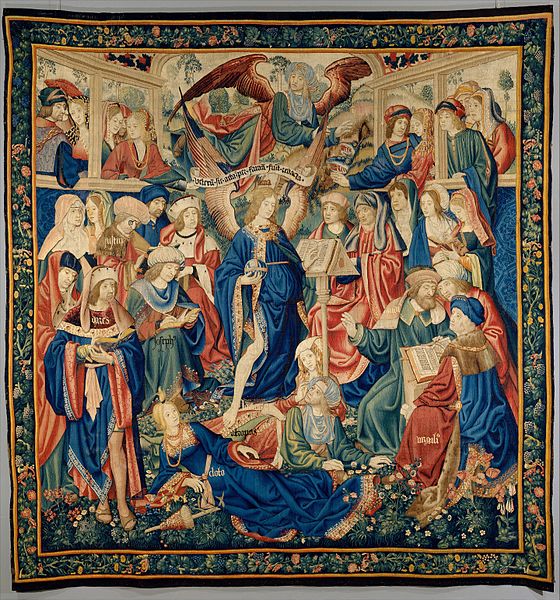The Lady and the Unicorn is the modern title given to a series of six tapestries created in the style of mille-fleurs and woven in Flanders from wool and silk, from designs ("cartoons") drawn in Paris around 1500. The set is on display in the Musée de Cluny in Paris.
The Lady and the Unicorn: À mon seul désir (Musée national du Moyen Âge, Paris)
The Dame à la licorne room of the Musée national du Moyen Âge (former Musée de Cluny)
Touch, 3.15 m × 3.58 m (10.3 ft × 11.7 ft)
Taste, 3.75 m × 4.60 m (12.3 ft × 15.1 ft)
Tapestry is a form of textile art, traditionally woven by hand on a loom. Normally it is used to create images rather than patterns. Tapestry is relatively fragile, and difficult to make, so most historical pieces are intended to hang vertically on a wall, or sometimes horizontally over a piece of furniture such as a table or bed. Some periods made smaller pieces, often long and narrow and used as borders for other textiles. Most weavers use a natural warp thread, such as wool, linen, or cotton. The weft threads are usually wool or cotton but may include silk, gold, silver, or other alternatives.
Weaving a small tapestry on a high-warp loom, 2022, New Zealand
One of the tapestries in the series The Hunt of the Unicorn: The Unicorn is Found, circa 1495–1505, The Cloisters, Metropolitan Museum of Art, New York City
Tapestry Room from Croome Court, moved to the Metropolitan Museum of Art, hung with made to measure 18th-century Gobelins tapestries, also covering the chairs. 1763-71
The Triumph of Fame, probably Brussels, 1500s








